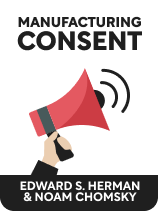

This article is an excerpt from the Shortform book guide to "Manufacturing Consent" by Edward S. Herman and Noam Chomsky. Shortform has the world's best summaries and analyses of books you should be reading.
Like this article? Sign up for a free trial here .
Does the United States truly practice the freedom of the press? Who decides what gets published and what doesn’t?
Despite the fact that the United States prides itself on having freedom of the press and freedom of speech, the authors of Manufacturing Consent argue that the elite class is censoring media. There are many ways they do this: using political power, limiting competition, pulling funding, etc.
Learn why Chomsky and Herman believe the media is being indirectly censored.
The Media Is a Tool of Elite Control
Chomsky and Herman assert that the free press is crucial to the success of a democratic system of government. After all, citizens in a representative democracy need timely and accurate information to make well-informed decisions and participate in self-government.
But, they argue, the American press has failed to meet this need and is censoring media. Instead of working to properly inform the public, the media’s coverage of events reflects and reinforces the political and economic views of the nation’s ruling class.
The authors argue that powerful interests—like politicians, military officials, wealthy media executives, and advertisers—act as media gatekeepers by wielding both financial and political power, thus determining what news is reported, what the public is allowed to see, and the range of opinions that can be expressed and represented in mainstream news outlets.
| The Decline of Media Gatekeepers and the Rise of Misinformation The indirect censorship of media content by political and economic elites can be dangerous to the healthy functioning of a free press and a democratic society. But recent developments have shown that the opposite can also pose a threat to a stable democracy—namely, the complete absence of any media gatekeeping. Indeed, critics argue that media gatekeeping is crucial to sustaining a healthy public discourse by ensuring that only evidence-based and factual stories can reach a wide audience. Many media critics hoped that the rise of the internet and social media would democratize the media landscape, enable a broader range of voices to be heard, and mitigate elite control of news content. Unfortunately, some observers note, the digitization of media has given rise to a wave of misinformation, as any content creator—regardless of their unscrupulousness, extremism, or lack of adherence to basic journalistic ethics—now has a wide platform to disseminate their views. Additionally, there is some concern that social media is particularly conducive to the spread of misinformation. According to one study of 126,000 stories shared on Twitter, fake news reaches more people and spreads faster on social media than actual news. Worse, false information tended to reach people six times faster than truthful stories and was 70% more likely to be shared by Twitter users than factual articles. |
Limiting the Scope of Conflict and Competition
Chomsky and Herman write that, although there is often significant divergence of opinions on major public issues between elites and the general public, the media consistently favors and promotes the opinions of the political establishment, marginalizes alternative voices, and limits debate and political competition to those relatively few subjects where there is some disagreement between factions of elites—such as between leading politicians of the two major political parties or between two powerful business competitors.
This dynamic can explain why certain political conflicts become major stories and others don’t. For example, the media paid great attention to the story that developed when, in 2019, President Donald Trump threatened to withhold military aid to Ukraine unless the Ukrainian authorities promised to publicly open an investigation into Hunter Biden (the son of Joe Biden, Trump’s reelection opponent).
However, Joe Biden had been a prominent national political figure for 50 years by that point, and his party, the Democratic Party, is one of the two major parties in the American political system. As fellow members of the political establishment, Biden and the Democrats had the means and resources to fight back—specifically by launching a congressional probe into Trump’s political misconduct that resulted in his impeachment on charges of abuse of power and obstruction of Congress.
But Biden isn’t the only political figure Trump attempted to intimidate, smear, or coerce in his efforts to retain political power. In the aftermath of the 2020 presidential election, which Trump refused to concede, he used his influence on social media to harass and intimidate obscure state and local election officials and civil servants—many of them fellow Republicans, but none of whom had the same means and resources to fight back as Biden did. The purpose of Trump’s intimidation campaign was to get these officials to publicly cast doubt on the legitimacy of Biden’s victory, which most of them refused to do. Although, as with Biden, Trump’s efforts were designed to subvert the democratic process, his attacks on local election administrators received far less media coverage.
| Centrism, Sensationalism, and Sexism: Other Forms of Bias The crux of Chomsky and Herman’s argument in this section is that mainstream media has a pro-elite bias, one that largely serves to reflect and amplify the views of the nation’s most powerful economic and political leaders. But other media observers have noted that the set of biases in the media runs deeper than simple elitism and encompasses other blind spots that distort how it covers events, including: -Bias toward centrism, in which the media tends to automatically split the difference between the political left and the political right and treat that middle ground as inherently reasonable or correct—regardless of the actual merits or truth of the left or right positions on a given issue -Bias toward sensationalism, in which the media gravitates toward stories and events that are unusual, eye-catching, or conflict-based, such as Donald Trump’s insults of other politicians on Twitter -Social biases like sexism or racism, which informs how the media covers certain events, like a female candidate running for president or a crime surge in a Black community—reinforcing the fact that the people who report the news are affected by the same biases that affect society as a whole |

———End of Preview———
Like what you just read? Read the rest of the world's best book summary and analysis of Edward S. Herman and Noam Chomsky's "Manufacturing Consent" at Shortform .
Here's what you'll find in our full Manufacturing Consent summary :
- How the American media frames events and creates narratives that serve the elite
- How elites indirectly censor media and avoid censorship laws
- Why corporate media outlets value profit above truth or news value






